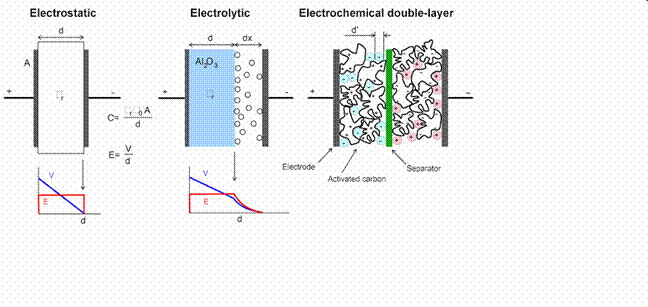Super Capacitor
Published on Nov 23, 2015
Abstract
Supercapacitor also known as electric double-layer capacitor (EDLC), super condenser, pseudo capacitor, electrochemical double layer capacitor, or ultracapacitors, is an electrochemical capacitor with relatively high energy density.
Compared to conventional electrolytic capacitors the energy density is typically on the order of hundreds of times greater. In comparison with conventional batteries or fuel cells, EDLCs also have a much higher power density.
In this article the use of super capacitors likes hybrid power supply for various applications is presented. The main application is in the field of automation. The specific Power of the super capacitors and its high lifetime (1 million of Cycles) makes it very attractive for the startup of the automobiles. Unfortunately, the specific energy of this component is very low. For that this technology is associated with battery to supply the starter alternator.
Introduction of Super Capacitor
Super capacitors also known as Electric double-layer capacitors, or electrochemical double layer capacitors (EDLCs), or ultracapacitors, are electrochemical capacitors that have an unusually high energy density when compared to common capacitors, typically on the order of thousands of times greater than a high capacity electrolytic capacitor. For instance, a typical electrolytic capacitor will have a capacitance in the range of tens of millifarads. The same size super capacitor would have a capacitance of several farads, an improvement of about two or three orders of magnitude in capacitance but usually at a lower working voltage. Larger, commercial electric doublelayer capacitors have capacities as high as 5,000farads.

In a conventional capacitor, energy is stored by the removal of charge carriers, typically electrons, from one metal plate depositing them on another. This charge separation creates a potential between the two plates, which can be harnessed in an external circuit. The total energy stored in this fashion increases with both the amount of charge stored and the Potential between the plates.
The amount of charge stored per unit voltage is essentially a function of the size, the distance, and the material properties of the plates and the material in between the plates (the dielectric), while the potential between the plates is limited by breakdown of the dielectric. The dielectric controls the capacitor's voltage. Optimizing the material leads to higher energy density for a given size of capacitor.
EDLCs do not have a conventional dielectric. Rather than two separate plates separated by an intervening substance, these capacitors use "plates" that are in fact two layers of the same substrate, and their electrical properties, the so-called "electrical double layer", result in the effective separation of charge despite the vanishingly thin (on the order of nanometers) physical separation of the layers. The lack of need for a bulky layer of dielectric permits the packing of plates with much larger surface area into a given size, resulting in high capacitances in practical-sized packages.
Super capacitor technology is based the electric double layer phenomenon that has been understood for over a hundred years. However, it has only been exploited by commercial applications for about ten years. As in a conventional capacitor, in an ultracapacitor two conductors and a dielectric generate an electric field where energy is stored. The double layer is created at a solid electrode-solution interface - it is, then, essentially a charge separation that occurs at the interface between the solid and the electrolyte. Two charge layers are formed, with an excess of electrons on one side and an excess of positive ions on the other side.
The polar molecules that reside in between form the dielectric. In most ultracapacitors, the electrode is carbon combined with an electrolyte. The layers that form the capacitor plate's boundaries, as well as the small space between them, create a very high capacitance. In addition, the structure of the carbon electrode, which is typically porous, increases the effective surface area to about 2000 m2/g
Green Technology Super Capacitors :
Activated carbon used is unsustainable and expensive. Biochar is viewed as a green solution to the activated carbon currently used in super capacitor electrodes. Unlike activated carbon, biochar is the byproduct of the pyrolysis process used to produce biofuels and it is nontoxic and will not pollute the soil when it is tossed out. Biochar costs almost half as much as activated carbon, and is more sustainable because it reuses the waste from biofuel production, a process with sustainable intentions to begin with.